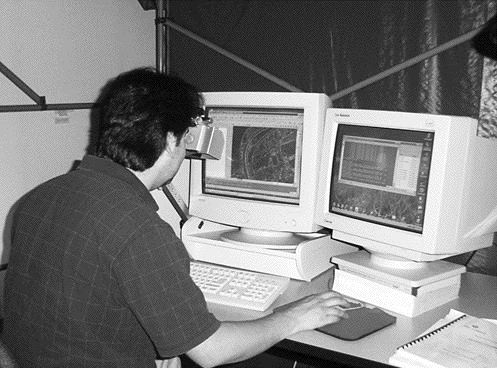Many mineral exploration properties are located in relatively inaccessible areas. These areas generally are poorly mapped, and the maps are outdated or difficult to acquire. An essential tool for a geologist is a good topographic map of his or her area that can be used to plan field programs.
Fortunately, there are satellites available to capture stereo images of these remote areas that, in turn, can be transformed into high-resolution topographic maps useful for grassroots exploration and drilling programs.
In the past, these maps were made by flying aircraft with attached mapping cameras over the area. These cameras took overlapping photos which, when viewed through stereo glasses, allowed a mapping technician to view the image in three dimensions and digitize roads, streams, elevation points, and other land features to build up a topographic map.
This aerial imagery could also be used as a backdrop to the map so that a geologist could see both the image and the map. By varying the flying height, the resulting maps could be very detailed to allow for site-specific planning, or less detailed for reconnaissance-level exploration.
Getting an aircraft to remote locations for mapping can be a problem, and aircraft availability may not coincide with a geologist’s need for preliminary exploration maps. This is when high-resolution satellites prove their value to geologists.
Once an order is placed with the satellite operator, he will try to capture an image of the area each time the satellite passes overhead.
In many cases, images can be acquired within 30 days of request and, as the satellite image is captured digitally, the imagery can be downloaded directly into mapping software without the need for first developing and scanning aerial film.
The IKONOS satellite from GeoEye is one of the high-resolution imaging satellites that can produce stereo images for mapping purposes. It can resolve ground features that are 81- by 81-cm or larger.
This means that a geologist should be able to identify objects such as individual trees, shrubs and large boulders in the image.
However, high-resolution satellite images have their limitations regarding the amount of ground detail that can be mapped and the positional accuracy of the maps.
Government agencies have defined horizontal accuracy standards for topographic maps of different scales. As an example, a reconnaissance-level topographic map may be at a scale of 1:50,000.
In general, the horizontal mapping accuracy for this scale is defined as 90% of well-defined features on the map falling within 25 metres of their true position. A more detailed topographic map at 1:5,000 should have features within 2.5 metres of their true position to meet the same mapping accuracy standards.
Maps also have a vertical component, shown as elevation contours. The vertical accuracy for a topographic map is at least the same as the horizontal accuracy. For example, a 1:50,000 topographic map should have a vertical accuracy of at least 25 metres, but can be larger in areas with extensive ground cover or steep slopes.
The published accuracy of IKONOS’ Reference Stereo is 25 metres horizontal and 22 metres vertical, at a 90% confidence level. The published accuracy of IKONOS’ Precision Stereo is 4 metres horizontal and 5 metres vertical, at a 90% confidence level. One should keep in mind, though, that in areas of heavy vegetation or steep slopes, these accuracies may not be achievable.
What does this mean to a geologist needing a map? By understanding the published accuracies for the satellite imagery, the geologist can select the appropriate satellite image product to get the desired output map.
Without this knowledge, he may request 2-metre contours from satellite imagery and get 2-metre contours, but the vertical accuracy of the contours may only be 22 metres.
For a reconnaissance-level topographic map, 30- to 40-metre contours may be appropriate. For more detailed topographic mapping, a geologist may consider generating 10-metre contours.
When a geologist is ready for detailed site planning for a mine, stereo-paired aerial photography is the most appropriate choice as the aircraft elevation can be varied to produce the desired accuracy.
There are other gridded satellite datasets available, such as the elevation data from the Shuttle Radar Topography Mission (SRTM). The elevation data within the U.S. is gridded to 30 metres and outside of the U.S., to 90 metres.
The published accuracy of SRTM imagery within the U.S. is 25 metres horizontal and 16 metres vertical at a 90% confidence level. Again, areas with heavy vegetation or steep slopes should be less precise.
For the SRTM dataset, one may want to consider producing contours at a 30-metre interval or larger. Making contours at a smaller interval does not necessarily provide more precision on the ground.
In summary, a geologist should always ask his or her mapping supplier about a map’s source imagery and the positional accuracy (both horizontal and vertical) that can be expected.
Otherwise, a geologist may make misinformed decisions on a drilling program or other field work.
— The author is GIS Business Manager of Vancouver-based McElhanney Consulting Services, which assists mining companies acquire stereo satellite imagery and aerial photography to produce topographic maps. He may be reached at kkliparchuk@mcelhanney.com or 604-683-8521.


Be the first to comment on "How to get the right satellite map"